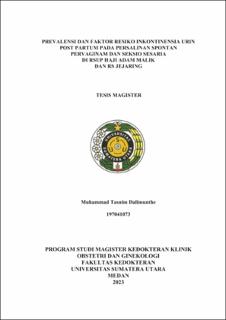Prevalensi dan Faktor Resiko Inkontinensia Urin Post Partum pada Persalinan Spontan Pervaginam dan Seksio Sesaria di RSUP Haji Adam Malik dan RS Jejaring

Date
2023Author
Dalimunthe, Muhammad Tasnim
Advisor(s)
Ardiansyah, Edy
Barus, Melvin Nova Gunawanto
Metadata
Show full item recordAbstract
Introduction: Stress urinary incontinence (SUI) is defined as the condition of involuntary leakage of urine due to the opening of the external urethra when abdominal pressure is increased, which is a common gynecological urinary disease. It is reported that 25% to 55% of pregnant women experience symptoms of urinary incontinence, and the incidence of SUI occurring after vaginal delivery is 3.7% to 19%. Urinary incontinence affects 17-45% of women worldwide and SUI is found in 48% of all cases. Vaginal delivery increases the risk of postpartum stress incontinence within one year postpartum compared with cesarean section. However, emergency cesarean section after full dilatation has a significant negative effect on the pudendal nerve as does vaginal delivery if there is prolongation of the second stage of labour.
Methods: This study was an observational analytic study with a case-control design to assess differences in urinary incontinence on the second and seventh days postpartum in spontaneous vaginal delivery (SVD) and cesarean section (CS) patients. The research sample was postnatal patients at H. Adam Malik General Hospital Medan and networking hospitals who met the inclusion and exclusion criteria. The sample collection was carried out using non-probability sampling, namely the consecutive sampling technique. Fill in the Questionnaire for Urinary Incontinence Diagnosis/QUID and cough test to identify the incidence of SUI on the second and seventh days postpartum. Data were analyzed descriptively to see the frequency distribution of research subjects based on the characteristics of the research sample.
Results: Based on this study, it was found that on the second postpartum day. 25 SVD patients (67.6%) and 13 CS patients (43.2%) were found with stress incontinence. Meanwhile, on the 7th postpartum day, 18 SVD patients (51.4%) and 1 CS patient (2.7%) were found with stress incontinence. The results of the statistical analysis showed that there was a significant difference in the incidence of stress incontinence based on the QUID assessment between the SVD and SC groups on the 7th postpartum day (p=0.000) and no significant difference was found from the results of the cough test between the SVD and SC groups (p=0.243).
